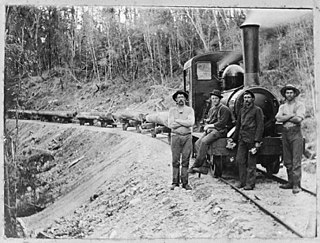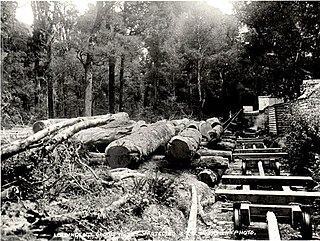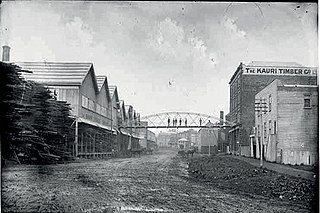 W
WBell Hill mill tramway was a bush railway at Bell Hill in the Moana Region of the Grey District on the West Coast of New Zealand. The tramway with a track gauge of 3 ft 6 in was used in the 1910s.
 W
WThe Brownlee Tramway of Marlborough, New Zealand, was a logging railway of the Rai and Pelorus Valleys used to take timber from the Carluke Sawmill through to the shipping port and mill of Blackball, Havelock. It operated from c.1881 through to 1915 as part of William Brownlee's extensive sawmilling operation in the area.
 W
WThe Bush Tramway Club is a heritage railway 12 km west of Huntly along the Rotowaro Road, in the Waikato region of New Zealand. It regularly operates restored locomotives along a 5.4 km Rotowaro-Glen Afton section of the former Glen Afton Branch. Open days are the first Sunday of each month.
 W
WThe Charming Creek Tramway was a 9 kilometres (5.6 mi) long private logging and mining railway at Ngakawau in Buller District on the West Coast in New Zealand. It was used from 1903 or 1905 to 1958.
 W
WEllis and Burnand was a New Zealand sawmilling and timber retailing company, formed by businessman John William Ellis and engineer Harry Burnand in 1891.
 W
WThe Ellis & Burnand Tramway was from 1922 to 1958 a 37 kilometres (23 mi) long forest railway near Ongarue in the central North Island of New Zealand with a gauge of 3 ft 6 in.
 W
WThe Hokitika & Kanieri Tramway was an 3.5 kilometres (2 mi) long, privately owned light railway with a gauge of 3 ft 6 in between Hokitika and Kaniere in the Westland District on the West Coast of the South Island, New Zealand, which operated from 1866 to 1914 as a horse-drawn tram and from the 1920s to 1950s as a logging railway.
 W
WThe Kauri Timber Company, Limited, (KTC) Auckland was from 1888 to 1944 a large logging and sawmilling company in New Zealand.
 W
WKnight's tram, Raurimu was a bush railway owned by the Tamaki Sawmill Co., Raurimu and managed by Len Knight. It was located at Raurimu in the central North Island of New Zealand, connecting to the North Island Main Trunk Railway. The tramway with a track gauge of 3 1⁄2 feet (1,067 mm) was used for at least ten years from 1912 to 1922.
 W
WThe Kokiri Tramway was at least from 1895 to the 1902 a forest railway with a gauge of 1,067 mm near Kokiri on the Arnold River in the west of New Zealand's South Island.
 W
WKūaotunu is a small coastal township at the east coast of the Coromandel Peninsula on the mouth of the Kuaotunu River on the North Island of New Zealand.
 W
WThe Makatote Tramway was from the late 1920s to 1940 a 2.6 kilometres (1.6 mi) long forest railway network near Makatote in the central North island of New Zealand with a gauge of 4 feet 1 inch (1,245 mm) using metal and wooden rails. It was operated by Dinwoodie's Timber Company with probably less than 10 employees.
 W
WThe May Morn Estates Tramway was a bush railway at Mangaroa, which crossed the Hutt River at Te Mārua near Upper Hutt on New Zealand's North Island. The company was incorporated in 1912 and operated their saw mill at least from 1914 to 1915.
 W
WMessrs. Smyth Brothers' Tramway was from 1897 to 1908 a forest railway in New Zealand.
 W
WThe Mokai Tramway was constructed by the Taupo Totara Timber Company to link their milling centre at Mokai with the New Zealand Government Railways line (NZR) at Putāruru in the Waikato region on the North Island of New Zealand. The more than 82 kilometres (51 mi) long light railway line was operated from 1903 to 1944 by the Taupo Totara Timber Company Tramway. It was handed over to NZR on 12 June 1950, and the section from Putāruru to Kinleith Mill south of Tokoroa is still being used for goods transport as of 2018.
 W
WThe Mountain Rimu Timber Company owned and operated a bush railway near Mamaku, south of the Kaimai Range near Rotorua in the Bay of Plenty Region of the North Island of New Zealand. The tramway, with a track gauge of 3 1⁄2 feet (1,067 mm), was used from approximately 1898, to at least 1935.
 W
WThe Piha Tramway was from 1906 to 1921 a 3-foot (910 mm) narrow gauge forest railway in New Zealand, the steepest sections of which were operated on inclines by steam-powered cable winches.
 W
WThe Port Craig tramway was an overall 24.4 kilometres (15.2 mi) long, private logging railway with a gauge of 3 ft 6 in at Port Craig in New Zealand, which operated from 1917 to 1928.
 W
WPrice's Bush Tramway was around 1903 bush railway near Akatarawa in the Tararua Range of New Zealand's North Island with a raised third rail for braking the loaden trucks like on the Rimutaka Incline.
 W
WThe Puke Puke Express was a logging railway with a gauge of probably 3 ft 6 in near Puke Puke in Oroua County in New Zealand.
 W
WStuart and Chapman's bush tramway, Rimu was a 20 kilometres (12 mi) long private logging railway with a gauge of probably 2 foot 6 inch at Seddon's Terrace Sawmill in Rimu, New Zealand. It ran south of Ross to the Lake Ianthe area. It was used from at least 1899 to 1962.
 W
WTaringamotu Tramway, nicknamed Taringamotu Express, was a bush railway near Oruaiwi, also known as Waituhi, a settlement in the valley of Taringamotu in the Manawatū-Whanganui region of New Zealand's North Island. It operated from 1910 to the mid 1960s.